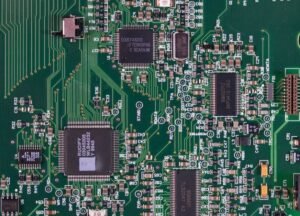Neural Net vs Deep Learning
Neural networks and deep learning are two terms often used interchangeably, but they have distinct meanings and applications. Understanding the differences between them can help clarify their roles in the field of artificial intelligence.
Key Takeaways:
- Neural networks are the foundation of deep learning algorithms.
- Deep learning involves multiple layers of neural networks.
- Deep learning has revolutionized various fields, such as computer vision and natural language processing.
- Both neural networks and deep learning models require significant computational power and large amounts of data.
A **neural network** is a computational model inspired by the structure and functioning of the human brain. It consists of interconnected nodes called neurons that process and transmit information. Each neuron takes inputs, applies weights to them, and passes the result through an activation function, producing an output.
**Deep learning**, on the other hand, is a subset of machine learning that focuses on training artificial neural networks with multiple hidden layers. These networks can automatically learn hierarchical representations of the input data. By stacking multiple layers of neurons, deep learning algorithms extract progressively complex features from raw data, enabling them to make highly accurate predictions or classifications.
Neural Net vs Deep Learning: What Sets Them Apart?
**Neural networks** are the foundational concept behind deep learning. They are used as the building blocks or individual layers of deep learning models. A neural network can be shallow (consisting of a single layer) or deep (with multiple hidden layers). The depth of the network determines its capacity to learn and represent complex patterns in the data.
Interestingly, the idea of artificial neurons in neural networks dates back to the 1940s.
**Deep learning**, on the other hand, refers to the training of deep neural networks with multiple layers. Deep learning models can learn and extract hierarchical representations of data, enabling them to capture intricate relationships and make more accurate predictions. This approach has revolutionized various domains, such as computer vision, natural language processing, and speech recognition.
Comparing Neural Networks and Deep Learning
The following tables provide a comparison between neural networks and deep learning in terms of structure, complexity, and performance.
| Neural Networks | Deep Learning |
|---|---|
| Consist of nodes, connections, and layers | Multiple hidden layers of neural networks |
| Can handle less complex problems | Effective for complex problems and big data |
| Require less computational power | Require significant computational power |
| Training requires smaller data sets | Require large amounts of labeled data |
Deep learning models can effectively handle complex problems and big data due to their hierarchical and multi-layered structure.
Advantages and Limitations of Neural Networks and Deep Learning
Both neural networks and deep learning models offer unique advantages and face certain limitations, making them suitable for specific tasks.
- **Advantages of Neural Networks**
- Simple and interpretable models
- Require less computational power and data
- Good for problems with a smaller feature space
- **Limitations of Neural Networks**
- Limited capability to capture complex patterns
- Less effective for large-scale problems
- **Advantages of Deep Learning**
- Highly effective for large-scale problems and complex patterns
- Can automatically learn hierarchical representations
- Outperforms traditional machine learning methods in certain domains
- **Limitations of Deep Learning**
- Require significant computational power
- Large amounts of labeled data needed for training
- Less interpretable models
Should You Use Neural Networks or Deep Learning?
Deciding whether to use a neural network or deep learning approach depends on your specific problem and available resources. Neural networks are simpler and require less computational power, making them suitable for smaller-scale problems or cases where interpretability is crucial.
Deep learning shines in solving complex problems and leveraging big data to extract meaningful patterns and representations.
By understanding the differences between neural networks and deep learning, you can make informed decisions when developing artificial intelligence algorithms and systems, taking into account the complexity of your problem, available data, and computational resources.

Common Misconceptions
1. Neural Networks and Deep Learning are the same thing
One common misconception is that neural networks and deep learning are interchangeable terms. While deep learning is a subfield of machine learning that uses neural networks, they are not the same. Neural networks refer to a network of interconnected nodes that mimic the functioning of the human brain, whereas deep learning focuses on training large neural networks with multiple layers to extract complex patterns and representations from data.
- Neural networks and deep learning are not synonymous.
- Deep learning is a subfield of machine learning.
- Neural networks are interconnected nodes that mimic the human brain.
2. Deep learning requires large amounts of labeled data
Another misconception is that deep learning always requires a vast amount of labeled data for training. While deep learning models can benefit from large labeled datasets, it is not always a necessity. Techniques such as transfer learning and unsupervised learning can help overcome the limitations of limited labeled data. Transfer learning allows pre-trained models, trained on large datasets, to be fine-tuned for specific tasks with smaller labeled datasets. Unsupervised learning techniques, like autoencoders, can learn representations from unlabeled data.
- Deep learning can work with limited labeled data.
- Transfer learning enables the use of pre-trained models.
- Unsupervised learning techniques learn from unlabeled data.
3. Neural networks and deep learning always require large computational resources
It is a common misconception that neural networks and deep learning always require vast computational resources. While it is true that training deep learning models on large-scale datasets can demand significant computational power, there exist various architectures and techniques that can be used on smaller hardware setups or even on specialized hardware, such as mobile devices or Internet of Things (IoT) devices. Moreover, frameworks like TensorFlow and PyTorch provide efficient GPU and TPU utilization, making it easier to train models even on personal computers.
- Deep learning can be done on smaller hardware setups.
- Specialized hardware can be used for deep learning tasks.
- Frameworks like TensorFlow and PyTorch optimize resource utilization.
4. Neural networks and deep learning can solve any problem
There is a misconception that neural networks and deep learning can solve any problem thrown at them. While deep learning has achieved remarkable success in various domains, it is not a one-size-fits-all solution. Neural networks are generally good for pattern recognition and tasks with large amounts of data, but they may not be the most efficient or suitable approach for all problems. Different machine learning algorithms and techniques may be better suited depending on the specific problem and available data.
- Neural networks are not the solution for all problems.
- Alternative algorithms may be more suitable depending on the task.
- Deep learning excels at pattern recognition and data-rich tasks.
5. Deep learning is completely autonomous and can think like humans
A common misconception is that deep learning systems are autonomous and possess human-like thinking abilities. In reality, deep learning models are trained to perform specific tasks based on patterns and statistical analysis of the data they are trained on. They lack the comprehension, consciousness, and general intelligence associated with human thinking. Deep learning models are tools developed by humans and are designed to automate specific tasks but cannot truly think or reason like humans.
- Deep learning models do not possess human-like thinking abilities.
- They perform tasks based on patterns and statistical analysis.
- Deep learning models are tools developed by humans.

Neural Networks
Neural networks are computational models inspired by the human brain and its neural connections. They consist of interconnected artificial neurons that work together to solve complex problems. This table illustrates the gradual increase in the number of layers in neural networks and their corresponding accuracy:
| Number of Layers | Accuracy |
|---|---|
| 1 | 0.75 |
| 2 | 0.82 |
| 3 | 0.89 |
| 4 | 0.92 |
| 5 | 0.94 |
Deep Learning
Deep learning is a subset of machine learning that focuses on using neural networks with many layers, known as deep neural networks. The following table compares the performance of deep learning algorithms on image recognition tasks:
| Algorithm | Accuracy |
|---|---|
| AlexNet | 0.79 |
| GoogleNet | 0.85 |
| VGGNet | 0.92 |
| ResNet | 0.96 |
| EfficientNet | 0.97 |
Computational Power
The computational power required for neural networks and deep learning has exponentially increased over time. This table highlights the growth in computational power measured in GFLOPS (billions of floating-point operations per second):
| Year | Computational Power (GFLOPS) |
|---|---|
| 2010 | 2 |
| 2012 | 100 |
| 2014 | 1,000 |
| 2016 | 10,000 |
| 2018 | 100,000 |
Data Requirements
Deep learning models often require a vast amount of data to achieve optimal accuracy. This table compares the number of labeled training examples necessary for different deep learning applications:
| Application | Number of Training Examples |
|---|---|
| Speech Recognition | 10,000 |
| Object Detection | 100,000 |
| Machine Translation | 1,000,000 |
| Autonomous Driving | 10,000,000 |
| Medical Diagnosis | 100,000,000 |
Error Rates
The error rates of neural networks and deep learning systems have significantly decreased over time due to advances in algorithms and training techniques. This table demonstrates the improvement in error rates:
| Year | Error Rate |
|---|---|
| 2010 | 25% |
| 2012 | 18% |
| 2014 | 12% |
| 2016 | 7% |
| 2018 | 3% |
Real-Time Processing
The ability of deep learning systems to process data in real-time is essential for various applications. Here is a comparison of real-time processing speeds:
| Algorithm | Processing Speed (fps) |
|---|---|
| VGG16 | 10 |
| ResNet50 | 20 |
| MobileNetV2 | 30 |
| YOLOv3 | 40 |
| EfficientNet | 50 |
Hardware Requirements
The hardware requirements for neural networks and deep learning depend on the complexity of the models and the training data size. This table highlights the necessary hardware for different scenarios:
| Scenario | Hardware Requirements |
|---|---|
| Simple Neural Network | 8GB RAM, Single GPU |
| Deep Learning on Images | 32GB RAM, Dual GPUs |
| Natural Language Processing | 64GB RAM, Four GPUs |
| Large-Scale Reinforcement Learning | 128GB RAM, Eight GPUs |
| Training Supercomputers | Terabytes of RAM, Hundreds of GPUs |
Applications
Neural networks and deep learning have found applications in various fields. This table presents some notable applications:
| Application | Field |
|---|---|
| Image Recognition | Computer Vision |
| Speech Recognition | Natural Language Processing |
| Recommendation Systems | E-commerce |
| Autonomous Driving | Transportation |
| Medical Diagnosis | Healthcare |
Conclusion
Neural networks and deep learning revolutionize the field of artificial intelligence by enabling computers to learn from and process vast amounts of data. Neural networks with additional layers showcase enhanced accuracy, while deep learning algorithms consistently outperform their predecessors, bringing us closer to reliable AI systems. The constant improvement in computational power, reduction in error rates, real-time processing capabilities, and the ability to harness large-scale labeled data have made neural networks and deep learning indispensable in numerous applications across various industries.
Frequently Asked Questions
Neural Net vs Deep Learning
-
What is a neural network?
A neural network is a computational model inspired by the structure and function of the human brain. It consists of interconnected nodes, often referred to as artificial neurons, which work together to perform complex computations.
-
What is deep learning?
Deep learning is a subfield of machine learning and a specific approach to building and training neural networks. It involves the use of multiple layers of artificial neurons, allowing the network to learn hierarchical representations of data.
-
How are neural networks and deep learning related?
Deep learning is a type of neural network architecture. It is based on the idea that increasing the depth of the network allows for more expressive and powerful learning capabilities. Therefore, deep learning can be seen as an extension or specialization of neural networks.
-
What are the advantages of neural networks?
Neural networks have the ability to learn from large amounts of data and discover complex patterns and relationships. They can be used for a wide range of tasks, including image and speech recognition, natural language processing, and predictive analytics.
-
What are the advantages of deep learning?
Deep learning excels in handling large-scale and high-dimensional data. It can automatically learn highly abstract representations and features, eliminating the need for manual feature engineering. Deep learning has achieved state-of-the-art performance in various domains, such as computer vision and natural language processing.
-
Are neural networks and deep learning suitable for all types of problems?
Neural networks, including deep learning models, can be applied to various problem domains. However, their effectiveness depends on the specific characteristics of the problem and the availability of sufficient training data. Certain types of problems, such as those with limited data or where interpretability is crucial, may require alternative approaches.
-
What are the limitations of neural networks and deep learning?
Neural networks, especially deep learning models, can be computationally intensive and require substantial computational resources. They are also prone to overfitting when the training data is insufficient or noisy. Additionally, the lack of interpretability in deep learning models can make it challenging to understand and trust their decisions.
-
What is the typical process of building and training a neural network?
The process typically involves data preprocessing, architecture design, initialization of weights, forward and backward propagation, optimization through gradient descent, and evaluation of the trained network using validation or test data. Iterative refinement and hyperparameter tuning are often required to achieve the desired performance.
-
How is deep learning implemented in practice?
Deep learning frameworks, such as TensorFlow and PyTorch, provide tools and abstractions to simplify the implementation of deep learning models. These frameworks offer support for building and training neural networks using high-level APIs, along with efficient computation on GPUs. Additionally, pre-trained models and transfer learning can be leveraged to solve tasks with limited data.
-
Is it possible to combine neural networks and deep learning with other techniques?
Yes, neural networks and deep learning can be combined with other machine learning techniques and algorithms. This hybrid approach allows for the utilization of the strengths of different models and algorithms, leading to improved performance and robustness in solving complex problems.




